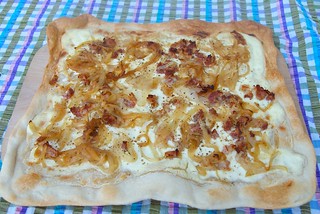In France Flammkuchen is called Tarte Flambée and is a bit like a thin crispy pizza but made without yeast. I started making it myself when I realised just how quick and easy it was.
200 g plain flour
2 tablespoons oil (ordinary vegetable or sunflower oil will be fine - olive oil is considered to not be authentic)
125 ml water
1 pinch salt
1 tablespoon butter (or butter and oil mixed)
200 g creme fraiche (I've used slightly less and it was enough)
200 g onions, sliced
100 g bacon, pancetta or similar, cut into thin strips
salt and pepper
Preheat oven to the highest temperature possible.
Thoroughly mix flour, oil, water and salt to make a dough which should be soft and stretchy but not sticky. Roll it out as thinly as possible (We're talking very thin here!) Lift the rolled out dough onto a lightly oiled baking sheet.
Optional: Melt the butter (or a mix of oil and butter) in a pan, add onions and sweat for just a couple of minutes. Add bacon, stir and heat through. If you slice everything thinly, you don't have to sautée it before putting it onto the base.
Spread creme fraiche on top of the dough (but not right to the edge), then spread onions and bacon over the top. Season with salt and pepper.
Put in a hot oven and bake for about 10-15 minutes. Once the edges look browned and crispy, it's done.
With salad, will feed two very hungry people or 3-4 with smaller appetites

You could also experiment with other toppings to make a vegetarian version, for example, olives and tomatoes or strips of red pepper.
A sweet version can be made by topping the creme fraiche with a thinly sliced eating apple (I used a Braeburn) and sugar flavoured with cinnamon.
Recipe sourced from Food.com and slightly adapted




